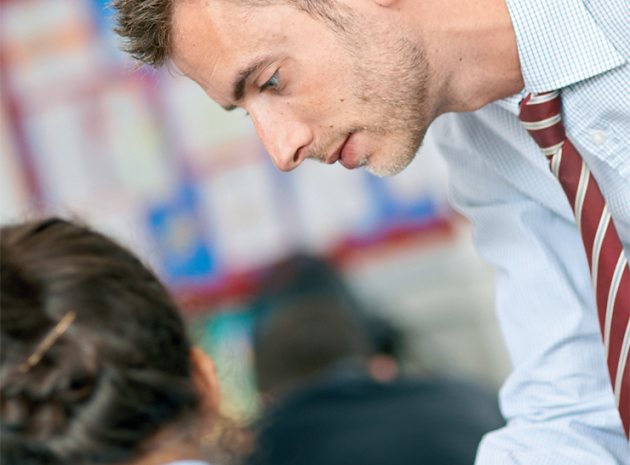On Your Mind
Understanding and prac tising mindfulness can make us more empathetic, compassionate – and therefore effective – teachers, say Ceri Seel and David Rycroft…
Ever been listening to a colleague talking about a situation with some year 9s? Moments later you disengage. Quite involuntarily, you get caught up in another train of thought. Though standing physically next to your colleague, your mind has been hijacked. She says your name and you click back into the present. But you have no clue how long she has been talking, nor what she has been talking about. If our minds can be absent for this (admittedly uncaptivating) colleague moment, how many other minutes, hours, days of our lives are we spending like automatons – the body going through the motions, but the mind lost in an endless labyrinth of repetitive thoughts? “But I like to think!”, you might say. “I have important things to think about”. The problem, science suggests, is that our wandering thoughts are often not happy ones.
Distraction
Doctoral research in 2010 using a Track-yourhappiness app for iPhones concluded that even if you’re doing something that’s enjoyable, it doesn’t seem to protect against negative thoughts. People are most happy when they are focused on what they are doing and nothing else. The evidence showed that mind wandering causes unhappiness and not that unhappiness caused mind-wandering, and that, on average, we are distracted, or ‘mind-wandering’, 47% of the time. So is this simply a fact of life, or is this situation workable?
Thankfully, recent neurological research concludes that with practice, we can actually rewire our brains, a property of the brain called neuroplasticity. Through changing our brains, we can change our minds. One of the most effective practices that provides and antidote to distraction and mind-wandering, is called mindfulness.
Mindfulness
Mindfulness has become something of a buzz word in mental health circles, partly because recent scientific research has been able to affirm through hard empirical evidence the benefits that mindfulness practitioners have long described from their subjective experience. For those of us that are not familiar with Mindfulness, here is a definition from expert Allan Wallace: Mindfulness is a face-to-face, engaged and present attitude of mind, without loosing, floating, or straying. We attend to whatever arises in witnessing mode : non-reactive, non-discursive and non-conceptual. It involves cultivating the ability to direct the attention to experience as it unfolds, with open-minded curiosity and acceptance. (John Kabat- Zinn). Crucially, the term ‘mind’ here doesn’t refer to just thinking and the intellect. Mindfulness practice isn’t a dry, intellectual pursuit. Rather, it is a heartful engagement with life – in fact, it has been sometimes called the practice of ‘heartfulness’.
How can mindfulness help me personally?
The definitions above may well indicate how mindfulness can be beneficial. Behind the technicalities of the practice, we are attempting to cultivate a different relationship with ourselves and our lives. Most of the time, we are constantly planning, strategising and anticipating: how am I going to fix things so I get what I want? How can I avoid pain? But the problem is, this doing mode can take over, and we are forever restless, scattered and fatigued. Through mindfulness practice, we are empowering another mode, a mode of being rather than doing. We remain in the awareness aspect of the mind, rather than chasing after its thoughts and feelings. In the worst case, thoughts and feelings appear like a bad movie we have to sit through; we know that they are not real and they won’t last. By practising like this, we are training our capacity to be with whatever arises with equanimity, and also enabling ourselves to find some space around our habitual reactivity, giving us the ability to choose how to respond freshly and appropriately to each unique moment of our lives, right now, in the present moment – which is, after all, the only moment we really have.
What do I actually do?
We train in mindfulness in formal sessions by resting our attention on a given focus. Mindfulness is about becoming more aware of our environment, our experience, and of the experiencer. Like many trainings, we start with the easiest and then progress gradually to more difficult practices. Our starting point is our body. We move the spotlight of our attention through the body, noticing the variety of sensations that arise. Our mind and our body make friends with each other. We can then progress to the less tangible arena of the mind and its contents.
PE is on the timetable; what about ME?
If we consider that the root of all our experience is our mind, it is astonishing that we haven’t yet developed a whole curriculum in every school to teach people, in the formative period of their lives, how to handle this mind and how to keep it healthy. PE is on the timetable, but why not ME as well? And it wouldn’t involve running around in shorts in the drizzle. There is a growing movement to bring mindfulness education into schools, because of it obvious benefits to students and to teachers. “Maths is a really useful skill for students to learn, and you can teach it in a way that builds selfesteem – but learning to develop compassion for oneself and for others is as vital, if not more so,” says Steve Cope, a maths teacher and a co-founder of education charity Mind with Heart.
Recent research by Patricia Jennings, PhD and Mark Greenberg PhD, shows that mindfulness programmes supporting teacher social-emotional competence, enhance the classroom environment, learning, as well as student social‐emotional development. There is also extensive evidence, (e.g. Burke, 2009; Harnett and Dawe, 2012) that mindfulness practice benefits pupils through increased emotional regulation, increased capacity to concentrate on tasks, and an ability to handle stress. It has been shown capable of improving mental health and well being, mood, self esteem, self regulation, positive behaviour and academic learning (Katherine Weare, 2013). The University of Exeter has also recently published some extensive research into effectiveness of the Mindfulness in Schools Programme, with positive results (Kuyken et al, 2013). Mindfulness practice is a great benefit to teachers, too. In the stressful school environment we can flex the presence-of-mind muscle, remaining more stable, spacious and effective in the face of teenage rebellion. Mindfulness practice has been described in this context as an opportunity to “tune the instrument of learning” (Kabat-Zinn, 2013). These sound like pretty crucial life skills and the cultivation of such skills requires extended training. Hence the need now for mindfulness to find its place in the education system. As busy teachers, we don’t want something extra to do. But mindfulness takes away a lot of the superimposed stress. By merely attending to the state of one’s mind and a sense of physical presence, we can deal with what is going on without adding layers of complications. We can face our frustration with our year 9s and approach the same class the next day afresh.
From mindfulness to compassion
When we act from a space of mindfulness, we are encouraged to approach the somewhat difficult, self-critical and judgemental aspects of ourselves with more gentleness and compassion. Genuine mindfulness cultivates a non-judgemental attitude both to oneself and to others, that naturally leads to a deeper sense of empathy and connectedness. Our relationships turn from being I-it to I-you, or even I-thou, and the ground is prepared for the flourishing of one of humanity’s greatest qualities, compassion. Strangely enough, the more care we feel for students and colleagues, the more energised and joyful we feel about ourselves.










